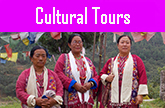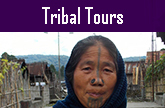Nagaland Tourism
Nagaland, the exquisite land of great valleys, wandering streams, abundant flora, deep ravines and soaring mountains is primarily a tribal state situated at an altitude of 4,900 feet. Acclaimed as the ‘Land of Festivals’, this lively land of cordial people is highly characterized by its multicoloured and uniquely designed attire, costumes and jewellery.
Nagaland : At A Glance
State Capital:
Kohima
Official Language:
English
State Animal:
Mithun (Bos frontalis)
State Bird:
Blyth's Tragopan
State Flower:
Rhododendron
State Tree:
Alder
Number of Tribes:
16
Sex Ratio:
931 females for each 1000 males (Census Report of India, 2011)
Population Density:
119 per square kilometer
Major Crops:
Rice, Maize, Wheat, Grams, Mustard, Cotton, Jute, Sugarcane
Major Plantations:
Tea, Rubber, Coffee
Major Minerals:
Coal, Limestone, Petroleum, Slate
Geographical Location:
Longitude 93°20' E to 95°15' E & Latitude 25°6' N to 27°4' N
Area
The mountain terrain of Nagaland encompasses an area of 16,579 sq. kilometers with 11 districts falling under its domain.
Population
Nagaland possesses a population of about 1,978,502 with 1,024,649 male and 953,853 female populations. (Census Report of India, 2011)
Literacy
The literacy rate of Nagaland is 79.55 % with a male literacy rate of 82.75 % and female literacy rate of 70.01%. (Census Report of India, 2011)
Climate
Nagaland has a torrential climate with an annual rainfall ranging between 175 cm and 250 cm. Heavy downpours occur from June to September comparatively with a low rainfall during April and May. The minimum temperature during winter remains within 4’ C followed by frost at high altitude. Nagaland has a short summer with a temperature between 16’ C to 31’ C. Strong north-west winds blow during the months of February and March.
Economy
Nagaland has an agrarian-based economy with 90% of the inhabitants engaged in agriculture. Jhum cultivation and tilling are highly practiced in the state growing crops like rice, corn, millets, pulses, tobacco, oilseeds, sugarcane and potatoes. Terrace farming is practiced by few tribes of the state. Forestry is another source of economy prevailing in Nagaland. Besides, a good amount of Govt. revenue is also derived from cottage industries such as weaving, woodwork and pottery.
History of Nagaland
Records regarding the ancient history of Nagaland are less available. The Nagas were earlier known as Naka in Burmese language meaning “people with pierced ears”. Social, economic and political based relations prevailed among the Naga tribes and the tribes in Assam and Burma. The authority of the area shifted to Burma’s direct rule due to some invasion that occurred in 1816. As a result, a great unrest and confusion continued in the Naga Hills during that period. The complete dominance of British East India Company over entire Assam in 1826 AD gradually sealed the fate of the Naga Hills (except Tuensang area) under the British rule by 1892 AD. In due course of time, the administration of the Naga Hills was brought joined along with Assam and remained even after independence.
Despite many conflicts in the political and administrative scenario, Nagaland achieved its official recognition as a separate a full-fledged state on 1st December, 1963 AD becoming the sixteenth state of Indian Union.
Culture of Nagaland
People
Beautifully carved designs and colours of shawls is a unique identification which differentiates a Naga tribe with other tribes of North East India. The origins of the Nagas are from the Indo-Mongoloid family speaking the Tibeto-Burman group of languages. This colourful land of warm people is the destination of 16 (sixteen) officially recognized tribes namely Angami, Ao, Chang, Chakhesang, Konyak, Khiamniungan, Phom, Pochury, Lotha, Sangtam, Rengma, Kuki, Sumi, Zeliang, Yimchunger etc. possessing its own unique dialect, customs, and traditional costumes. Among these tribes, the Angamis, Aos, Konyaks, Sumis and Lothas are the largest tribes in the state.
Festivals
Festivals of Nagaland are characterized by various shades of hue and music. Agriculture, being the main source of livelihood, harvest festivals dominates a major part of the cultural scenario of Nagaland. Monyu, Amongmong, Miu & Tsokum, Metemneo, Tokhu Emong, Moatsu and Terhunji are some of the prominent harvest festivals celebrated praying for a good yield. Other festivals are Naknyulum, Aoling, Meleyingi, Sekrenyi, Tulini and Ngada.
Folk dance and songs are an integral part of Naga culture which unfolds a grand blending of music and rhythm. The romantic and historical Naga folk songs sing of famous ancestors and ancient incidents. Seasonal songs dominate every harvest festival of Nagaland. Tribal and war dances are indispensable dance forms reflecting the colourful festive scenario of Nagaland. Famous dance forms of Nagaland are Monyu Asho, Melo Phita, Changsang, Kukuyipheto, Nokinketer Tsungsang, Aghushi Kighelhe, Langnyu-Khiamtsangshe, Rukhyo-Sharu, Khupielili and Akok-Khi.
Hornbill Festival
Hornbill Festival is one of the prominent seven day long festival celebrated exclusively in Nagaland every year during first week of December. This festival is organized at Naga Heritage Village situated in Kisama Village of Kohima, organized by the State Tourism and Cultural Department. Participated by all the tribes of Nagaland, this festival is observed to promote inter-tribal interaction and development of the cultural heritage of the state. Famously, the festival is named after the Hornbill bird which is admired in folklores of most of the Naga tribes. Colourful ancient attire, sharp weapons, feathers of hornbill, nails and teeth of Tiger and other animals used as ornaments worn by the tribes identify this unique festival of Nagaland. War Dance is a popular dance form performed during this festival. Hornbill festival offers a great platform to the tribes where they display their unique art and crafts including paintings, wood carvings & sculptures, hunting skills, ethnic food fairs, indigenous sports and games like Naga Wrestling, Traditional Archery etc. which attracts a great number of tourists every year. Some other attractions of Hornbill festival include Hornbill International Motor Rally, Vintage Car Rally, Hornbill Global Film Festival, Hornbill National Rock Contest, North East India drum chow, Literature Fest, Beauty Contest & Fashion Shows, Music Concerts, Konyak fire eating show, Naga king chilly eating contest, Pork fat eating contest, Flower shows and its sale, Stalls selling herbal medicine, local food etc.
Nagaland : Places to Visit
 Kohima Kohima |
 Dimapur Dimapur |
 Wokha Wokha |
 Tuensang Tuensang |
 Mokokchung Mokokchung |
 Mon Mon |
 Khonoma Khonoma |
 Tuophema Tuophema |
North East India Tourism
Nagaland Tour Packages
At Arkaya Holidays, we offer a variety of quality travel services to our global travellers across the planet who share sincere passion for travelling. Our travel packages specially designed for the promotion of Nagaland Tourism ensures happiness, safety and comfort in the “Land of Festivals”. Travel smiling.


















